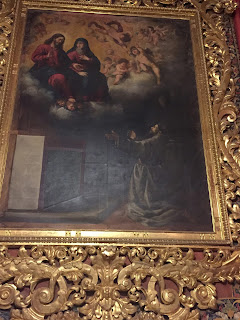Whenever I try to explain what Thanksgiving is to Spaniards, I end up failing miserably at explaining it in any meaningful way. When my roommate C asked me to clarify what the day was like, I finally found the perfect explanation. It's like any typical Spanish Sunday.
You see, what I love about Thanksgiving is the fact that the point of the day is FOOD. That's also the point of a typical Spanish Sunday--the mid-day meal, which for many is a few courses, maybe a large rice dish like a paella.
Sure, the rest of the day may have other activities (watch the Macy's Thanksgiving Day Parade, watch football, take a tryptophan-induced nap, or go to a movie), but the point is to eat a lot of food, to linger at the table and chat about life (and hopefully not politics--especially this year, ay madre mía!), and to just in general pause, exist, and express our gratitude for the life we have. But the thing that I love the most about Thanksgiving is what in Spain we would call the sobremesa: the post-dinner chat when all the plates are finished (or mostly-finished), and everyone feels fat, happy and relaxed.
And so, Friendsgiving legitimately turned into a very Spanish Thanksgiving after we had all spent a few hours, and given our thanks and written some thank-you notes, and after I had given a short talk about the history of Thanksgiving (of which, let's face it, I only remember a bit because I learned it back in kindergarten with the Pilgrims and the Indians and sowing the fields with fish so that they would be well-fertilized. The things you remember when you're 5!).
I went ahead and took a short video of the more Spanish side of the festivities:
You see, what I love about Thanksgiving is the fact that the point of the day is FOOD. That's also the point of a typical Spanish Sunday--the mid-day meal, which for many is a few courses, maybe a large rice dish like a paella.
Sure, the rest of the day may have other activities (watch the Macy's Thanksgiving Day Parade, watch football, take a tryptophan-induced nap, or go to a movie), but the point is to eat a lot of food, to linger at the table and chat about life (and hopefully not politics--especially this year, ay madre mía!), and to just in general pause, exist, and express our gratitude for the life we have. But the thing that I love the most about Thanksgiving is what in Spain we would call the sobremesa: the post-dinner chat when all the plates are finished (or mostly-finished), and everyone feels fat, happy and relaxed.
And so, Friendsgiving legitimately turned into a very Spanish Thanksgiving after we had all spent a few hours, and given our thanks and written some thank-you notes, and after I had given a short talk about the history of Thanksgiving (of which, let's face it, I only remember a bit because I learned it back in kindergarten with the Pilgrims and the Indians and sowing the fields with fish so that they would be well-fertilized. The things you remember when you're 5!).
I went ahead and took a short video of the more Spanish side of the festivities:

















































